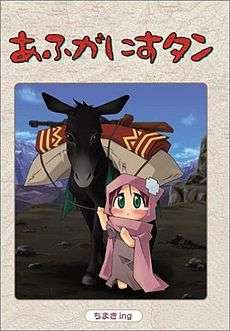Afghanis-tan
| Afghanis-tan (Afghanistan) | |
|
Japanese edition cover | |
| あふがにすタン (Afuganisu-tan) | |
|---|---|
| Genre | Comedy, History, Moe |
| Manga | |
| Written by | Timaking (ちまきing) |
| Published by | SansaiBooks |
| Magazine | Online |
| Original run | October 2003 – February 2005 |
| Volumes | 1 |
| Manga | |
| Pakis-tan | |
| Written by | Timaking (ちまきing) |
| Published by | SansaiBooks |
| Magazine | Online |
| Original run | February 2005 – Late Winter/Early Spring 2005 |
| Volumes | 1 |
Afghanis-tan (あふがにすタン Afuganisu-tan, see note on name below) or Afghanistan is a Japanese yonkoma manga, originally published as a webcomic, by Timaking (ちまきing). It is also the name of the heroine of the manga. The manga is nicknamed Afgan (あふがん Afugan)
Background
Afghanis-tan illustrates the modern history of Afghanistan and its neighboring countries, starting from the imperialist era in the 19th century, through moe anthropomorphism. The title character, a short and clumsy bishōjo, is a national personification of Afghanistan. Other female characters personify the nearby nations of Central Asia, such as Pakistan and Uzbekistan. Nations that have fought wars in Afghanistan at various times, such as Britain, the Soviet Union and the United States also make appearances. The Taliban government and Al-Qaeda terrorist group are also represented in the comic.
Each yonkoma strip is accompanied by an "Afghan Memo" that explains in prose some of the background and history of the nations depicted. Additional pages give short biographies of the characters.
The fact that it is a moe manga depicting international conflict, and the fact that it personifies countries, have drawn a little criticism. However, it has also drawn attention for its attempt to blend an appropriate depiction of the history and background of each country with the personality of its characters.
Afghanis-tan has finished, and work on its sequel, "Pakis-tan", was suspended after four editions.
On July 26, 2005, after several delays, the series went on sale as a comic book, "Afghanis-tan" (ISBN 4-86199-009-2).
Characters
- Note that most of the character names are written in Japanese the same way the country they represent is written, only with a katakana emphasis on the "-tan" suffix
- Afghanis-tan (あふがにすタン Afuganisu-tan, represents Afghanistan)
- The protagonist of the series, an unfortunate girl surrounded by neighbors with strong personalities. According to her character description, "she trips and falls a lot". Her design appears to be based on Sharbat Gula, an Afghan woman whose iconic photo appeared on the cover of the June 1985 issue of National Geographic.
Pakis-tan (ぱきすタン Pakisu-tan, represents Pakistan)
- Boastful, and often feels lonely, especially without Kashmir. Likes Afghanis-tan.
Uzbekis-tan (うずべきすタン Uzubekisu-tan, represents Uzbekistan)
- Stubborn and a sore loser. Often quarrels with Pakis-tan. idolizes "Older-Sister Russia".
Tajikis-tan (たじきすタン Tajikisu-tan, represents Tajikistan)
- A salt-of-the-earth Edokko type, quick to argue and quick to make up. Has girlish tastes.
Kyrgyzs-tan (きるぎすタン Kirugisu-tan, represents Kyrgyzstan)
- Quick-thinking and sharp-tongued. Always riding on a wooden horse.
Turkmenis-tan (とるくめにすタン Torukumenisu-tan, represents Turkmenistan)
- A girl with a mysterious personality - one never knows her true thoughts. (Cf. Saparmurat Niyazov)
Meriken (めりけん represents the United States)
- The richest person in the neighborhood. Good in a fight.
Al-Nyaida (あるにゃいだ Arunyaida, represents Al-Qaeda)
- A group of feral cats causing trouble in the neighborhood. Come to live in Afghanis-tan's house while she is out.
Reception
As it makes it easy for readers to learn about the history and geography of Central Asia, topics which Japanese people are not very familiar with, it could be thought of as an educational text. Around the time when the book was published by Sansai Books, again, part of the intention was to provide information about the current state of Afghanistan.
There is criticism that using the style of "moe" trivializes the situation. In particular, the terrorist attacks of September 11, 2001 were depicted as "an incident where a cat called Al-Qaeda bit America", a fact which was severely criticized in the secondary work, "Introduction to the Kashmir conflict (カシミール紛争入門 Kashimīru Funsō Nyūmon)".
Collections
| No. | Title | Release date | ISBN |
|---|---|---|---|
| 1 | Afghanis-tan (あふがにすタン, Afuganisu-tan) | July 26, 2006 | ISBN 978-4-8619-9009-0 |
| 2 | Pakis-tan (ぱきすタン, Pakisu-tan) | August 30, 2008 | ISBN 978-4-8619-9116-5 |
See also
- Hetalia: Axis Powers — a series with a similar premise, but instead employs bishōnen to represent Italy and its interactions with other countries, particularly around World War I and World War II.
References
- Much of this article was translated from the equivalent article in the Japanese Wikipedia, accessed on September 1, 2006.
- "Popular Web Mangaka Vanishes After Winny Incident". Anime News Service. 5-2-06
External links
- (Japanese) Partial archive of Afghanis-tan site (many images not available)
- Afghanis-tan (manga) at Anime News Network's encyclopedia
